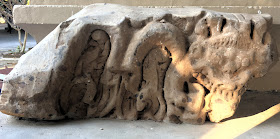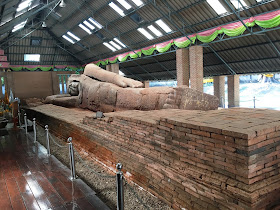Mueang Sema Historical Area
This Apple Maps screen grab shows the Mueang Sema historical area. The small circular moat is probably Mon from the 7th century. It is on private property and there are no signs to direct visitors. As far as I know, it has never been studied and there is no effort at preservation.
The rectangular moat is probably Khmer from about the 11th century. Part of it is on public land.
The large circular moat with berm surrounds almost all of the monuments in the historic area. It is probably Khmer.
The very large circular moat which surrounds the entire area is a mystery.
Some photos of the historic area at the end of this blog. But first, a few stops along the way.
Wat Nam Cha
Small road leading to Wat Nam Cha in Kham Talay Soh.
Wat Nam Cha. On the right are the remains of some Khmer sandstone building blocks.
Lingam and Yoni at Wat Nam Cha. The Lingam represents Shiva and the Yoni represents Shakti. These are Hindu deities (not Buddhist). I can't tell the age, but these are probably 11th century Khmer.
Very old Sema Stone at Wat Nam Cha
This bas relief sandstone carving was probably part of a lintel on a Khmer prang (tower) or other structure. This is a long shot, but I think the figure on the right is Kala, a "swallowing" monster also known as Kirtimukha. A less-worn lintel with Kala is below:
The cropped image on the right (not mine) shows a stone lintel from Phimai depicting the swallowing monster Kala. Compare with the cropped image on the left from Wat Nam Cha.
The full stone lintel from Phimai depicting the marriage of Shiva and Parvati who are situated just above the swallowing monster Kala.
Another piece of what is probably the same lintel.
The pole frame and wooden siding of this old ubosot (ordination hall) at Wat Nam Cha is protected by a modern roof.
Old sema stone protrudes through the floor of the old ubosot at Wat Nam Cha.
This is so strange. A Buddha image standing on top of an old Hindu Yoni. I'm not sure if some symbolism was intended or if the Yoni was just handy. At Wat Nam Cha.
Wat Nam Cha
Wat Nam Cha. The Buddha image on the left is sitting on an ancient Yoni. Strnage.
Buddha images inside the old ubosot at Wat Nam Cha.
The foundation of the old ubosot at Wat Nam Cha was made from sandstone building stones that were certainly the remains of whatever Khmer structure originally occupied the space. The lintel, lingam, several yoni all indicate that this was an important Hindu site during the Khmer era beginning in the 11th century. This is one of many such sites that stretch from Angkor Wat in present day Cambodia to Phimai in Korat, Thailand and on to Mueang Sema, also in Korat.
Buddha Image? No idea. At Wat Nam Cha.
Exterior of old ubosot at Wat Nam Cha.
Wat Pong Burapharam
Monk enjoys a smoke breat at Wat Pong Burapharam. I asked him if there were any old stones or Khmer artifacts around. I guess he didn't hear clearly as he directed me to the toilets.
Old wood from deconstructed wat buildings.
Wat Samakkhi Samoson Ban Pong Daeng
This beautiful old ubosot is in the late Rattanakosin style and probably dates from the last half of the 19th century. It was locked and no one seemed to know where to find the key. I didn't get inside.
Old wooden-wheeled wagons on the grounds of Wat Samakkhi Samoson Ban Pong Daeng.
Lam Takhong River
Prasat Mueang Kao
Luk Nimit and Sema Stone at Prasat Mueang Kao. Luk Nimit are roundish stones that are buried under Sema Stones which mark the holy boundaries of a Buddhist ubosot or ordination hall. Prasat Mueang Kao is a Khmer structure, but Buddhism and Hindu coexisted in this part of Thailand throughout the Khmer era.
Pond at Prasat Mueang Kao
This old Khmer structure, Prasat Mueang Kao, is in a district named Korach. One version of history has it that there were once twin cities in this area: Mueang Sema and Khorakhapura which became Nakhon Raj and then Nakhon Ratchasima also known as Korat. I think most of this is supposition and not based on any written history.
Corbelled arch at Prasat Mueang Kao. The Khmer never used a true arch and instead used the Corbelled arch for vaulted spaces.
Yoni at Prasat Mueang Kao
Aligned doorways at Prasat Mueang Kao
The circular holes were used for dowels to make moved the building stones easier for the masons.
This main building is almost all sandstone
This auxiliary building is entirely made of laterite except for the door frames.
Whoever restored this site used all the leftover pieces to build a perimeter wall. Clearly, some of the leftovers were designed for some other purpose.
This cupola would have served as the top of the main structure at Prasat Mueang Kao. I'm not sure why they didn't completely reconstruct it.
There are very few directional road signs in this important cultural area. Many are Thai only.
Prasat Non Ku - This Khmer structure has both brick and sandstone. The bricks look new. No idea if they are historically accurate.
Window colonettes at Prasat Mueang Khaek
Mueang Sema Historic Area
The berm on the right is part of the rectangular moat which encloses a much smaller circular moat.
This is all that remains of the circular moat. It is entirely on private property, so there are no signs. As far as I know, none of this has been studied and there is no attempt at preservation.
One of the better preserved Khmer monuments (#7). This one appears to be all brick. Some of the others use both laterite and sandstone. This one is at the north entrance of the historic area.
A portion of the large circular moat has been cared for and contains water. This is at the south entrance of the historic area.
Wat Dhammachraksemaram (Wat Phra Non)
Old sema stones on display in situ. No idea how old or even from what era.
This is the oldest reclining Buddha image in Thailand. It was made during the Mon-Dvaravati period in the 7th century.
More sema stones and a platform, the purpose of which is not explained.
Headed Home
Lunch. Pork chop Isaan style.
My lunch had insufficient carbohydrates to sustain an 80K ride. I fixed that by having sugary lemon tea and a piece of chocolate cake at this lovely spot at Khok Kruat.
Animated video of bike ride. For some reason, no photos made it into the video.






















































No comments:
Post a Comment